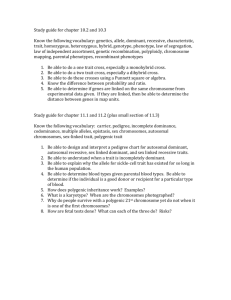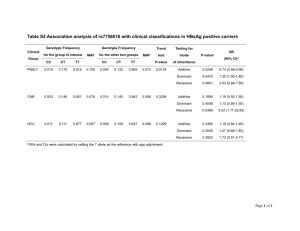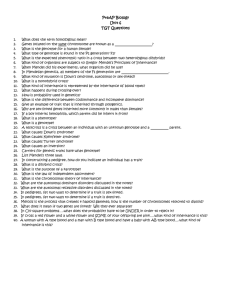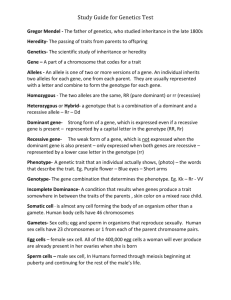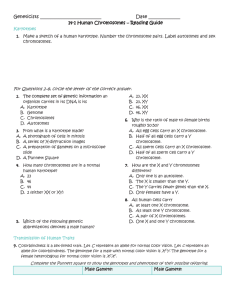Date
advertisement
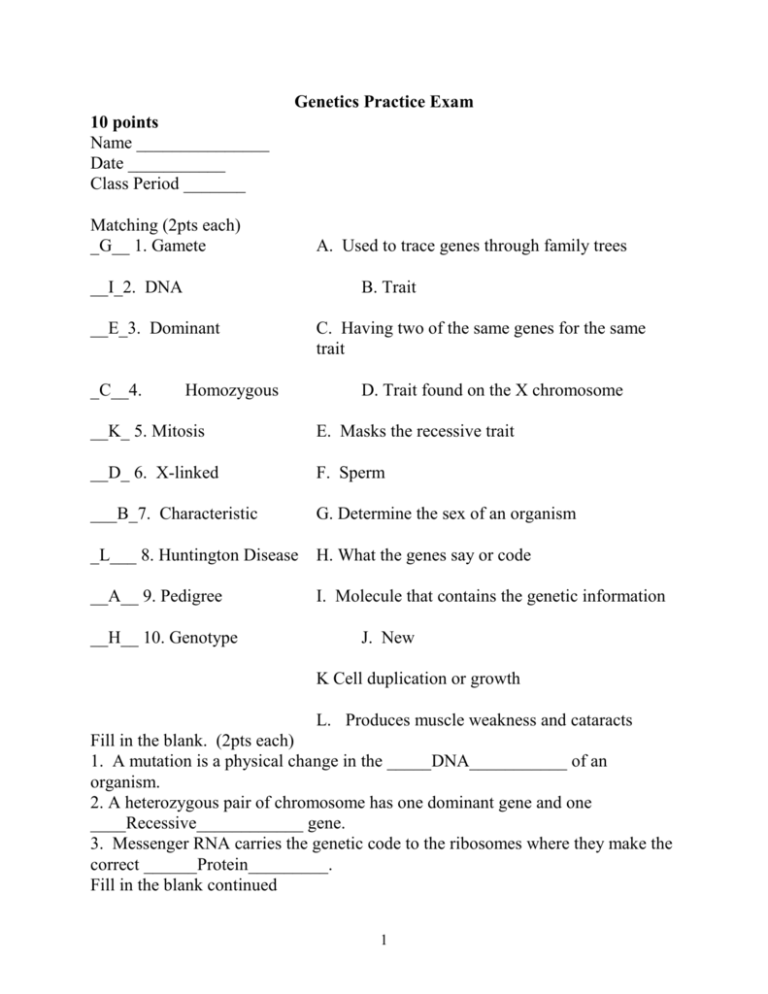
Genetics Practice Exam 10 points Name _______________ Date ___________ Class Period _______ Matching (2pts each) _G__ 1. Gamete __I_2. DNA B. Trait __E_3. Dominant _C__4. A. Used to trace genes through family trees Homozygous C. Having two of the same genes for the same trait D. Trait found on the X chromosome __K_ 5. Mitosis E. Masks the recessive trait __D_ 6. X-linked F. Sperm ___B_7. Characteristic G. Determine the sex of an organism _L___ 8. Huntington Disease H. What the genes say or code __A__ 9. Pedigree I. Molecule that contains the genetic information __H__ 10. Genotype J. New K Cell duplication or growth L. Produces muscle weakness and cataracts Fill in the blank. (2pts each) 1. A mutation is a physical change in the _____DNA___________ of an organism. 2. A heterozygous pair of chromosome has one dominant gene and one ____Recessive____________ gene. 3. Messenger RNA carries the genetic code to the ribosomes where they make the correct ______Protein_________. Fill in the blank continued 1 4. ______Probability________________ is used to calculate the chances of something happening. General Formula for Probability: Occurrence/ Possible Outcomes Eg. A coin- Occurrence would be heads or tails (1). Possible outcomes is 2 (heads or tails) 5. Haploid is __half_____________ the number of chromosomes of somatic (regular) cells. Short answers. Write complete sentences. (5pts each) 1. Explain how the sex of the baby is caused in humans and why half of the population is male and half female. In humans the egg always carries and X chromosome. At fertilization the sperm that fertilizes the egg is either carrying an X chromosome or a Y chromosome but not both. There is a 50% chance that the sperm is carrying X and a 50% chance it is carrying Y. Because the chances are 50/50 half the population is female and half is male. 2. Who was Gregor Mendel? Describe his research and explain why he is called the father of genetics. Gregor Mendel was an Austrian monk who performed experiments using pea plants. His experiments which were not appreciated during his lifetime provide the basis for what is now known as Mendelian Genetics. Mendelian Genetics describes dominance, recessivness, independment assortment of genes and other concepts which are the basis of genetics today. 2 3. A Reebop is a marshmallow creature. There is a Reebop around that has the following genotype for several traits: DD (Dd) Aa Nn Using the following table, how many dominant, codominant and recessive traits is the Reebop expressing? Dominant- one (three body segments) Codominant- TWO- one antennae, orange nose Recessive- Zero Genotype DD Dd dd AA Aa aa NN Nn nn Phenotype Three body segments Three body segments Two body segments Two antennae One antennae No antennae Pink Nose Orange Nose Green Nose Define the following. Write complete sentences. One point will be lost for each incomplete sentence written. (3pts each) 1. Phenotype - The phenotype is the physical expression of the genotype. 2. Carrier- A carrier has one copy of a recessive allele that is masked by the dominant allele so they have the dominant phenotype. 3 3. Codominance- Codominance is a situation where the phenotype is between the dominant phenotype and the recessive phenotype. The reebops had many codominant traits such as one antennae and orange noses. 4. Allele- An allele is a form of a gene, for example the genes for blue eyes, green eyes and brown eyes are all alleles Multiple choice. Circle the correct answer (2pts each) 1. What is a gene? a. A section of DNA that codes one trait b. A chromosome c. A whole strand of DNA d. None of the above 2. A plant with the genotype RR is crossed with a plant with the genotype rr. What percentage of the offspring would be predicted to have the genotype Rr? a. 25% b. 50% c. 75% d. 100% 3. A human skin cell contains a. 4 chromosomes b. 16 chromosomes c. 23 chromosomes d. 46 chromosomes 4. What letters stand for the bases that make the genetic code in DNA? a. FGAT b. CGUA c. CGAT d. GADC 5. A human with the chromosomes XX is a. A male. b. A dwarf. c. A female d. An example of failure of genes to separate during meiosis. 4 6. Mitotic division produces two daughter cells with a _______ number of chromosomes, while meiosis produces four daughter cells with a _______ number of chromosomes. A. haploid, diploid B. diploid, haploid C. haploid, haploid D. diploid, diploid 7. A recessive allele t is responsible for a condition called distonia. A man who has this condition marries a woman who doesn't. One of their four children has the condition. What are the possible genotypes of the man and woman? A. The father is Tt; the mother is TT. B. Both parents are tt. C. The father is tt; the mother is TT. D. The father is tt; the mother is Tt. 8. An expert in x-ray crystallography this scientist took a photo that was critical to the discovery of the structure of DNA in the 1950’s A. Oswald Avery B. Herbert Boyer C. Rosalind Franklin D. Barbara McClintock E. James Watson 9. A gene showing codominancea. has both alleles independently expressed in the heterozygote b. has one allele dominant to the other c. has alleles tightly linked on the same chromosome d. has alleles expressed at the same time in development e. has alleles that are recessive to each other 10. Replication of DNA: a. takes place in a “conservative” manner b. takes place in a “dispersive” manner c. takes place in a “semi-conservative” manner d. usually involves one origin of replication per chromosome e. in eukaryotes takes place only in the cytoplasm Probability (3pts each) 1. What is the probability of flipping four pennies and having all four come up as heads? 1 in _16_____ 5 2. What is the probability of tossing two 6-sided die and having both come up on the number 4?1 in ___36___ 3. Shown below is a representation of a fruit fly's 10 chromosomes, 5 of which it inherited from its father (depicted in dark) and 5 of which it inherited from its mother (depicted in light). 5 What is the probability that a particular sperm cell produced by this fly contains copies of the 5 chromosomes that were inherited from the fly's mother, as shown below? The probability =1 in __32_____ Extra credit Probability Problems 1. If the father is heterozygous for eye color, and the mother is also heterozygous for eye color what is the chance that the offspring will inherit two homozygous recessive chromosome? (1pt) 1 in __4__ 2. This problem concerns three traits found on three different chromosomes in pea plants. The first trait is for height of the plant where tall is dominant (T) over short (t). The second is for the color of the seed where green (G) is dominant over yellow (g) and the third trait is the texture of the seed coat where round (R) is dominant over wrinkled (r). A heterozygous tall, heterozygous green seeded, heterozygous yellow plant (Tt,Gg,Rr) is crossed with an identical plant (Tt,Gg,Rr). What is the probability that a plant that is all homozygous recessive will be produced? (tt,gg,rr) (5pts) 6 1in _64__ 7
